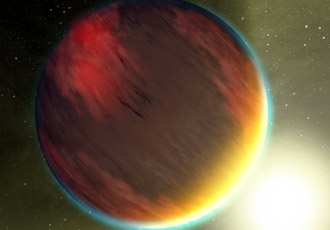It turns out that those planets of the type known as "hot Jupiters" are colder and drier than what was commonly thought

NASA's Spitzer Space Telescope has managed for the first time to capture enough light from planets outside the solar system to detect the signature of molecules in their atmospheres. The breakthrough is a significant step towards the ability to detect life on rocky planets and it comes many years before astronomers expected it.
Astronomers have managed to measure the infrared radiation of two planets orbiting stars similar to our Sun. HD 189733b, seen here in the artist's simulation, lacks common molecules such as water and methane. The astronomers hypothesize that these molecules are present but are hiding under a deep layer of clouds containing nitrogen.
"It's an amazing surprise," said Michael Werner, a Spitzer project scientist at NASA's Jet Propulsion Laboratory in Pasadena, California. "We had no idea when we designed Spitzer that it would be able to take such a dramatic step in characterizing exoplanets.
Spitzer was able to record the spectra of two gaseous planets. HD 189733b which is 62.9 light-years away in the direction of the constellation Vulpecula (located in the summer triangle), and HD 209458b which is 150 light-years away in the direction of the constellation Pegasus.
These two planets are called "hot Jupiters" because they are Jupiter-type gas giants but orbit their Sun at a close distance. The data indicates that these planets are colder and drier than expected. The theory was that hot Jupiters would contain a lot of water in their atmosphere, but surprisingly no water was found in any of them. In addition, HD 209458b even found remains for the formation of small sand grains - silicates in the atmosphere. It is still possible that the water is in the atmosphere of the planet but it is hidden under clouds of dust, of the kind that we do not know in the solar system.
Prof. Jeremy Richardson from NASA's Goddard Space Flight Center in Maryland said that "water in the form of vapor cannot escape from such a large planet and therefore it must have been hiding, it is possible that it is under the dust clouds that we discovered in the spectrum measurements" he said. Richardson is the lead researcher on a paper appearing today (February 22, 2007) in the journal Nature describing the findings from the observation of the planet HD 209458b. Another team led by Mark Swain (Swain) from JPL also focused on the same planet and reached similar results that were submitted for publication in the Astrophysical Journal Letters.
Another team, led by Carl Grillmair of the Spitzer Space Telescope Science Center at the California Institute of Technology in Pasadena, captured the spectrum of HD 189733b. This research will soon be published in the Astrophysical Journal Letters.
"With the help of these observations, we can refine the tools that will one day be needed to detect life, if it exists elsewhere," Swain said. "It's actually a kind of general rehearsal." added
Spitzer's observation was made by a method known as a "secondary eclipse", a method according to which the telescope monitors the planet as it passes behind its star and temporarily disappears from the field of view. By measuring the infrared light from the planet as it disappeared, Spitzer's spectrograph was able to obtain the planet's information alone. This technique only works in the infrared range where the planet is brighter than in visible light and even competes with the bright glow of its star.
In previous observations of HD 209458b, the Hubble Space Telescope was able to measure changes in the light coming from the star – not the planet – as the planet passed in front of it. These observations were able to show the existence of several elements such as sodium, carbon, oxygen and hydrogen floating at the very edge of the planet's atmosphere.
To the page of the planet HD 209458b on Wikipedia
